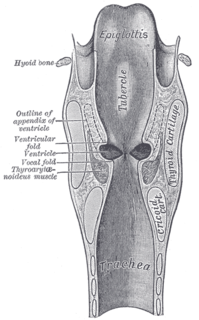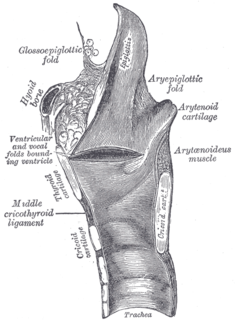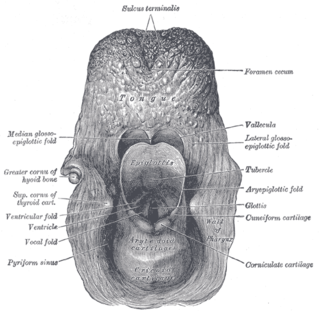| Laryngeal vestibule | |
|---|---|
 Coronal section of larynx and upper part of trachea. (Laryngeal vestibule not labeled, but visible near region labeled "Tubercle") | |
| Details | |
| Identifiers | |
| Latin | vestibulum laryngis |
| TA | A06.2.09.007 |
| FMA | 55406 |
| Anatomical terminology | |
The portion of the cavity of the larynx above the vocal folds is called the laryngeal vestibule; it is wide and triangular in shape, its base or anterior wall presenting, however, about its center the backward projection of the tubercle of the epiglottis. It contains the vestibular folds, and between these and the vocal folds are the laryngeal ventricles. [1]

The larynx, commonly called the voice box, is an organ in the top of the neck of tetrapods involved in breathing, producing sound, and protecting the trachea against food aspiration. The larynx houses the vocal folds, and manipulates pitch and volume, which is essential for phonation. It is situated just below where the tract of the pharynx splits into the trachea and the esophagus. The word larynx comes from a similar Ancient Greek word.

The epiglottis is a flap in the throat that keeps food from entering the windpipe and the lungs. The flap is made of elastic cartilage covered with a mucous membrane, attached to the entrance of the larynx. It projects obliquely upwards behind the tongue and the hyoid bone, pointing dorsally. It stands open during breathing, allowing air into the larynx. During swallowing, it closes to prevent aspiration and forcing the swallowed liquids or food to go along the esophagus instead. It is thus the valve that diverts passage to either the trachea or the esophagus.

The laryngeal ventricle, is a fusiform fossa, situated between the vestibular and vocal folds on either side, and extending nearly their entire length. There is also a sinus of Morgagni in the pharynx.
Contents
The vestibule is an opening in the lateral wall of the larynx, between the vestibular fold above and the vocal folds below. It is the inlet to another cavity in the lateral wall of larynx, the laryngeal ventricle. The vestibular fold is formed by the vestibular ligament extending from the lateral walls of the epiglottis to the arytenoid cartilage covered with mucous membrane. The vocal fold is the upper free margin of the conus elasticus which is covered by mucous membrane. The conus elasticus or lateral ligament is the lateral thickened part of the cricothyroid membrane.

The arytenoid cartilages are a pair of small three-sided pyramids which form part of the larynx, to which the vocal folds are attached. These allow and aid in the vocal cords' movement.

A mucous membrane or mucosa is a membrane that lines various cavities in the body and covers the surface of internal organs. It consists of one or more layers of epithelial cells overlying a layer of loose connective tissue. It is mostly of endodermal origin and is continuous with the skin at various body openings such as the eyes, ears, inside the nose, inside the mouth, lip, vagina, the urethral opening and the anus. Some mucous membranes secrete mucus, a thick protective fluid. The function of the membrane is to stop pathogens and dirt from entering the body and to prevent bodily tissues from becoming dehydrated.













